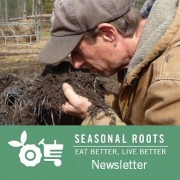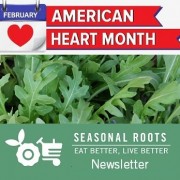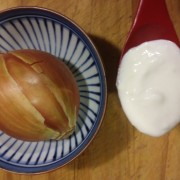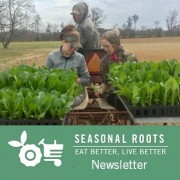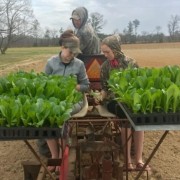The step-by-step guide to kids healthy snacks
This is how you get kids to make good snack choices like these!
– By the Veggie Fairy Team
This cutie’s mom, Beth, snapped her son’s picture to show what happened after she joined Seasonal Roots and got into eating local.
“My son just came home from school and these were HIS choice of snack!” Beth reported. “In the past he would go for something in the pantry. He loves the fresh veggies as much as I do!”
The average American kid snacks three times a day, and chips, candy, and other junk foods account for almost a third of their daily caloric intake. That discovery was revealed by a study that came out in Health Affairs Journal in 2010. Since then, childhood obesity rates have continued to rise, so apparently not much has changed.
Lucky for us locavores, local food can make change happen. It tastes so good that kids naturally love it, and it’s really good for you. So first of all: GO LOCAL!
Next, when it comes to kids healthy snacks, experts say it’s not the between-meal-snacking that’s the problem — it’s the quantity, quality, and timing of what you’re eating that counts.
Eat 6 times a day
Eating every few hours during your waking hours keeps your metabolism cranked up so you burn off calories. Starving yourself or your kids between meals and/or cramming all your calories into one or two big meals a day does the opposite. It tells your body that food is scarce. To get you through this time of “scarcity”, your body slows down your metabolism to use fewer calories now, storing those calories for later by converting them into fat.
So it’s better to eat six small meals a day — with three of those meals being super small, a.k.a. snack-size, like an apple and a handful of nuts.
Eat within a 12-hour window or less
The one time it’s okay to “starve” yourself between meals is overnight (or whatever time of day you sleep.) Multiple studies have shown that if you eat your breakfast at, say, 8:00am, and then eat your last snack of the day before 8:00pm, you’re more likely to keep weight off and stay healthier.
Scientists aren’t exactly sure why this is true. But they believe it could be that the timing of when you eat influences your body’s internal clock. Meal times affect your circadian rhythm more than whether or not the sun is up. Circadian rhythm impacts the function of many genes that are known to affect metabolism. And metabolism is involved in whether your body burns calories… or stores them.
Science has also uncovered another possibile explanation: Your body needs downtime to repair itself from the day’s wear and tear, right down to the cellular level. If you go to sleep with a big meal in your stomach, your body will spend its night shift processing those calories instead of keeping up with its daily overnight repair duties.
Use snack time to supplement kids’ diets
Snack time can accomplish so much more than just postponing hunger pangs! It’s actually an opportunity to fill in whatever might have been missing from the last meal you or your children ate. For example, if you had cereal and milk for breakfast, what’s missing? Fruit! Serve up an apple or berries. That way you’re using snack time to complement the bigger meals.
Mix it up
One of the most common bad-snacking habits: Eating too much of one kind of food, like crackers, chips, or cookies. Worse, processed foods like that are often made with artery-clogging trans fats. These are usually labeled as ‘partially hydrogenated oil’ in the ingredients list.
Rather than offer kids just one food item as a snack, combine at least two food groups, like a protein and a carbohydrate. That can be as simple as serving a granola bar with a glass of naturally sweet grassfed milk, full of healthy fats your body needs. Other local food combos: peanut butter and whole wheat crackers or bread, a boiled egg and carrot sticks, grassfed cheese and a pear, or hummus and pita. Combo snacks like those deliver a one-two punch: more nutrients plus they’re more filling, to tide kids over until the next meal.
Think small
The point of snacking is to keep hunger pangs at bay while enjoying something tasty. Snacking isn’t about eating until you’re stuffed. Instead of handing your kids whole bags of chips, dole out small portions into small plastic bags or containers that can be grabbed on the go. Or leave out a snack-sized serving on a plate.
Go local!
Healthy snacks start with healthy ingredients, and you can’t beat local food that’s produced sustainably and humanely… and flavorfully. If it tastes better, Beth’s son is proof that kids will naturally love it.
Local produce that’s freshly harvested has more nutrients and flavor than grocery store produce that’s a week old or older. Locally made artisan goods are created with wholesome, recognizable ingredients, no toxic preservatives or additives. And local grassfed dairy and meat, and pasture-raised chicken and eggs, are so much more nutritious and delish than industrial-farmed animals. All that fresh air, room to roam, and natural diet makes for happier animals, too.
To make healthy snacking a habit, it also has to be convenient. That’s where Seasonal Roots comes in. Members like Beth can order every week and home-delivery is included, so there’s always something fresh and tasty on hand.
Click here for a list of all the amazing benefits of grassfed, compiled by Wendy and Keith of Saddle Ridge Farm, one of the local farms in our online farmers market.
Click here to learn more about why avoiding midnight snacks makes you healthier.
Click here for 20 creative snack ideas for kids that will make snack time delicious, healthy, and best of all, fun!
ABOUT SEASONAL ROOTS
Since 2011, Seasonal Roots’ online farmers market has connected Virginia families with local family farmers who use sustainable, humane practices. Our veggie fairies – mostly moms who believe in living better through scrumptious, healthy eating, being kind to animals, protecting the environment, and spreading joy – home-deliver freshly harvested produce, eggs, grass-fed dairy and meat, plus artisan fare. We empower our members to eat better and live better with more nutritious, flavorful food that’s good for us and good for the planet. More info at seasonalroots.com.

